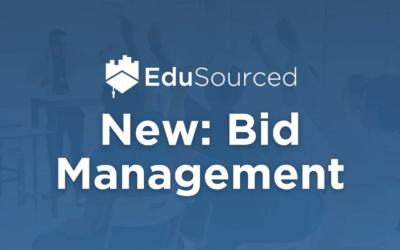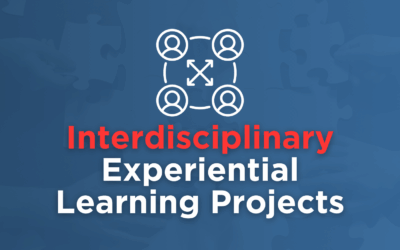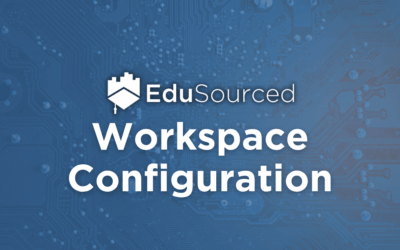 Guest post by Andrew Allen, Director of Experiential Learning at University of Illinois Gies College of Business
Guest post by Andrew Allen, Director of Experiential Learning at University of Illinois Gies College of Business
We recently hosted a webinar –sponsored by EduSourced – to talk about our journey in scaling experiential learning at Gies Business. Here is a quick re-cap, along with responses to some of the questions we didn’t have time to address.
You can watch the full webinar here.
Summary:
At Gies Business, we have a motto: “real-world experience for every student”. This is not experience for experience sake, but to prepare students to succeed in work and in life. And it’s working.
Scaling experiential learning is a key challenge for our program. By the time we finish this monumental change, we will have the largest experiential learning course in the country (Business 301) and will conduct 200 client projects per year with undergraduate and graduate students alike. The Illinois MBA is one of the most hands-on MBA programs in the country, where students conduct real-world projects every semester – and even manage other project teams. In the corporate learning and executive education space, we are delivering programs that enable professionals to both learn and practice theory in real-time.
We believe the education of the future is a blend of theory, principles and real-world application, through a seamless and highly engaging experience.
Q&A:
What is Business 301? Scaling experiential learning is hard. How do you teach 900 students per year on 150 client projects?
Business 301 is a new addition to our undergraduate core curriculum. All Gies students take the course during their junior year. In the course, students work in teams solving a problem for a live client. Each team works with a separate client, creating a more intense and immersive experience.
We will teach the course over two semesters. This equates to 9 sections per semester taught by 3 faculty (blend of tenure-track and specialized faculty). The key to delivering a high-quality experience hinges on two aspects: (1) Our flipped classroom model. We have a large video library created by multiple faculty specifically for this course. The content covers three themes: How to work in a team; How to solve a problem; How to sell your solution and manage a client. (2) In our Project Management in Action Course, we train a select group of MBA students (called “Senior Managers”), who have already participated in two client-based courses. These MBAs each oversee 4 Action Learning teams each. They guide and mentor the teams and grade project deliverables. Faculty deliver and reinforce content and coach teams in the classroom.
How are projects and clients sourced?
Projects are sourced by professional staff in our Action Learning office, in collaboration with our Career Services and Alumni Engagement teams. Our projects come from three main channels: Employers, Alumni and “Local” (i.e. pool of 100 companies in our Research Park, local businesses and nonprofits). The Action Learning office provides this service to faculty so faculty can focus on instruction and coaching in the classroom.
How do students select or get matched to projects?
Students review the list of projects and rank order their top 5 or top 8. We then form teams, making an effort to match them to one of their top choices, while creating balanced and diverse teams. While students at first often want to work on a “high profile” client, they find that some of the best project experiences are sometimes with small and mid-sized businesses.
What do we charge?
We do not charge a fee for our Action Learning projects. Our goal is to create a meaningful real-world experience for our students to help them succeed in life after graduation. Charging a fee for these projects could prove counter-productive to our goals because it introduces expectations and complications that may not align with our goals. However, we do allow clients the opportunity to provide a financial gift at the end of the project.
Do students sign a Non-Disclosure Agreement?
All of our students sign an NDA at the beginning of the semester. We treat client information seriously and coach students how to talk about their experience in job interviews and on their resume while respecting confidential client information. To streamline the process, we ask all of our clients to accept our university-sanctioned NDA rather than asking us to sign their own NDA – which would add complexity and delays to the projects.
What’s the value of using the EduSourced platform?
We’ve tried multiple solutions to managing our projects: Salesforce, excel spreadsheets, internal shared drive, etc. For us the value of EduSourced is the combination of these features:
- Acts as a centralized, searchable database of project files and client contact information
- Allows us to streamline the project submission process – through an online webform that feeds into EduSourced
- Allows us to track project progress on the Dashboard tab. When managing 80 projects per year (and 200 when we get to full scale), we need a snapshot view of how the projects are going. Our MBA Senior Managers review these milestones and follow up with teams as needed
- Allows clients to share files securely with the team (contracts, NDAs, company data)
- Delivers automated peer evaluations, client evaluation and student impact surveys which are all crucial to managing the student experience, telling our story and measuring success – both for AACSB reporting as well as for keeping internal and external stakeholders updated
Note: Salesforce could do some of these pieces as an off-the-shelf tool, but would require a large amount of customization to provide all of these features. We do not use all the features offered by EduSourced (for example, our students tend to use tools like Slack to communicate as a team, but the tool is still crucial for us to be able to scale and manage our courses and program).



